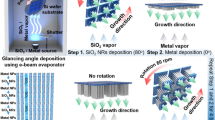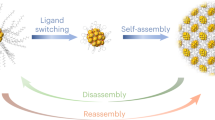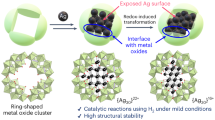Abstract
Tuning reagent and catalyst concentrations is crucial in the development of efficient catalytic transformations. In enzyme-catalysed reactions the substrate is bound—often by multiple non-covalent interactions—in a well-defined pocket close to the active site of the enzyme; this pre-organization facilitates highly efficient transformations. Here we report an artificial system that co-encapsulates multiple catalysts and substrates within the confined space defined by an M12L24 nanosphere that contains 24 endohedral guanidinium-binding sites. Cooperative binding means that sulfonate guests are bound much more strongly than carboxylates. This difference has been used to fix gold-based catalysts firmly, with the remaining binding sites left to pre-organize substrates. This strategy was applied to a Au(I)-catalysed cyclization of acetylenic acid to enol lactone in which the pre-organization resulted in much higher reaction rates. We also found that the encapsulated sulfonate-containing Au(I) catalysts did not convert neutral (acid) substrates, and so could have potential in the development of substrate-selective catalysis and base-triggered on/off switching of catalysis.
This is a preview of subscription content, access via your institution
Access options
Subscribe to this journal
Receive 12 print issues and online access
$259.00 per year
only $21.58 per issue
Buy this article
- Purchase on Springer Link
- Instant access to full article PDF
Prices may be subject to local taxes which are calculated during checkout



Similar content being viewed by others
References
van Leeuwen, P. W. N. M. Supramolecular Catalysis (Wiley-VCH, 2008).
Raynal, M., Ballester, P., Vidal-Ferran, A. & van Leeuwen, P. W. N. M. Supramolecular catalysis. Part 1: non-covalent interactions as a tool for building and modifying homogeneous catalysts. Chem. Soc. Rev. 43, 1660–1733 (2014).
Raynal, M., Ballester, P., Vidal-Ferran, A. & van Leeuwen, P. W. N. M. Supramolecular catalysis. Part 2: artificial enzyme mimics. Chem. Soc. Rev. 43, 1734–1787 (2014).
Meeuwissen, J. & Reek, J. N. H. Supramolecular catalysis beyond enzyme mimics. Nature Chem. 2, 615–621 (2010).
Breit, B. Supramolecular approaches to generate libraries of chelating bidentate ligands for homogeneous catalysis. Angew. Chem. Int. Ed. 44, 6816–6825 (2005).
Dydio, P. & Reek, J. N. H. Supramolecular control of selectivity in transition-metal catalysis through substrate preorganization. Chem. Sci. 5, 2135–2145 (2014).
Breslow, R. & Dong, S. D. Biomimetic reactions catalyzed by cyclodextrins and their derivatives. Chem. Rev. 98, 1997–2011 (1998).
Hooley, R. J. & Rebek, J. Jr . Chemistry and catalysis in functional cavitands. Chem. Biol. 255–264 (2009).
Dong, Z., Luo, Q. & Liu, J. Artificial enzymes based on supramolecular scaffolds. Chem. Soc. Rev. 41, 7890–7908 (2012).
Vriezema, D. M. et al. Self-assembled nanoreactors. Chem. Rev. 105, 1445–1489 (2005).
Fiedler, D., Leung, D. H., Bergman, R. G. & Raymond, K. N. Selective molecular recognition, C−H bond activation, and catalysis in nanoscale reaction vessels. Acc. Chem. Res. 38, 351–360 (2005).
Koblenz, T. S., Wassenaar, J. & Reek, J. N. H. Reactivity within a confined self-assembled nanospace. Chem. Soc. Rev. 37, 247–262 (2008).
Pluth, M. D., Bergman, R. G. & Raymond, K. N. Proton-mediated chemistry and catalysis in a self-assembled supramolecular host. Acc. Chem. Res. 42, 1650–1659 (2009).
Yoshizawa, M., Klosterman, J. K. & Fujita, M. Functional molecular flasks: new properties and reactions within discrete, self-assembled hosts. Angew. Chem. Int. Ed. 48, 3418–3438 (2009).
Wiester, M. J., Ulmann, P. A. & Mirkin, C. A. Enzyme mimics based upon supramolecular coordination chemistry. Angew. Chem. Int. Ed. 50, 114–137 (2011).
Amouri, H., Desmarets, C. & Moussa, J. Confined nanospaces in metallocages: guest molecules, weakly encapsulated anions, and catalyst sequestration. Chem. Rev. 112, 2015–2041 (2012).
Leenders, S. H. A. M., Gramage-Doria, R., de Bruin, B. & Reek, J. N. H. Transition metal catalysis in confined spaces. Chem. Soc. Rev. 44, 433–448 (2015).
Tominaga, M., Suzuki, K., Murase, T. & Fujita, M. 24-Fold endohedral functionalization of a self-assembled M12L24 coordination nanoball. J. Am. Chem. Soc. 127, 11950–11951 (2005).
Harris, K., Fujita, D. & Fujita, M. Giant hollow MnL2n spherical complexes: structure, functionalisation and applications. Chem. Commun. 49, 6703–6712 (2013).
Harris, K., Sun, Q.-F., Sato, S. & Fujita, M. M12L24 spheres with endo and exo coordination sites: scaffolds for non-covalent functionalization. J. Am. Chem. Soc. 135, 12497–12499 (2013).
Bruns, C. J. et al. Emergent ion-gated binding of cationic host–guest complexes within cationic M12L24 molecular flasks. J. Am. Chem. Soc. 136, 12027–12034 (2014).
Gramage-Doria, R. et al. Gold(I) catalysis at extreme concentrations inside self-assembled nanospheres. Angew. Chem. Int. Ed. 53, 13380–13384 (2014).
Best, M. D., Tobey, S. L. & Anslyn, E. V. Abiotic guanidinium containing receptors for anionic species. Coord. Chem. Rev. 240, 3–15 (2003).
Schug, K. A. & Lindner, W. Noncovalent binding between guanidinium and anionic groups: focus on biological- and synthetic-based arginine/guanidinium interactions with phosph[on]ate and sulf[on]ate residues. Chem. Rev. 105, 67–113 (2005).
Burrows, A. D., Harrington, R. W., Mahon, M. F. & Teat, S. J. Structural manipulation of hydrogen bond networks using sulfonated phosphane ligands and their complexes: competition and interplay between strong and weak hydrogen bonds. Eur. J. Inorg. Chem. 1433–1439 (2003).
Russell, V. A., Etter, M. C. & Ward, M. D. Layered materials by molecular design: structural enforcement by hydrogen bonding in guanidinium alkane- and arenesulfonates. J. Am. Chem. Soc. 116, 1941–1952 (1994).
Xiao, W., Hu, C. & Ward, M. D. Guest exchange through single crystal–single crystal transformations in a flexible hydrogen-bonded framework. J. Am. Chem. Soc. 136, 14200–14206 (2014).
Fujita, D., Takahashi, A., Sato, S. & Fujita, M. Self-assembly of Pt(II) spherical complexes via temporary labilization of the metal–ligand association in 2,2,2-trifluoroethanol. J. Am. Chem. Soc. 133, 13317–13319 (2011).
Li, D. et al. Viral-capsid-type vesicle-like structures assembled from M12L24 metal–organic hybrid nanocages. Angew. Chem. Int. Ed. 50, 5182–5187 (2011).
Kikuchi, T., Murase, T., Sato, S. & Fujita, M. Polymerisation of an anionic monomer in a self-assembled M12L24 coordination sphere with cationic interior. Supramol. Chem. 20, 81–94 (2008).
Desmarets, C., Ducarre, T., Rager, M. N., Gontard, G. & Amouri, H. Self-assembled M2L4 nanocapsules: synthesis, structure and host–guest recognition toward square planar metal complexes. Materials 7, 287–301 (2014)
Desmarets, C., Gontard, G., Cooksy, A. L., Rager, M. N. & Amouri, H. Encapsulation of a metal complex within a self-assembled nanocage: synergy effects, molecular structures, and density functional theory calculations. Inorg. Chem. 53, 4287–4294 (2014).
Genin, E. et al. Room temperature Au(I)-catalyzed exo-selective cycloisomerization of acetylenic acids: an entry to functionalized γ-lactones. J. Am. Chem. Soc. 128, 3112–3113 (2006).
Harkat, H., Weibel, J.-M. & Pale, P. A mild access to γ- or δ-alkylidene lactones through gold catalysis. Tetrahedron Lett. 47, 6273–6276 (2006).
Lee, L.-C. & Zhao, Y. Metalloenzyme-mimicking supramolecular catalyst for highly active and selective intramolecular alkyne carboxylation. J. Am. Chem. Soc. 136, 5579–5582 (2014).
Cavarzan, A., Scarso, A., Sgarbossa, P., Strukul, G. & Reek, J. N. H. Supramolecular control on chemo- and regioselectivity via encapsulation of (NHC)-Au catalyst within a hexameric self-assembled host. J. Am. Chem. Soc. 133, 2848–2851 (2011).
Wang, Z. J., Brown, C. J., Bergman, R. G., Raymond, K. N. & Toste, F. D. Hydroalkoxylation catalyzed by a gold(I) complex encapsulated in a supramolecular host. J. Am. Chem. Soc. 133, 7358–7360 (2011).
Hart-Cooper, W. M., Clary, K. N., Toste, F. D., Bergman, R. G. & Raymond, K. N. Selective monoterpene-like cyclization reactions achieved by water exclusion from reactive intermediates in a supramolecular catalyst. J. Am. Chem. Soc. 134, 17873–17876 (2012).
Wang, Z. J., Clary, K. N., Bergman, R. G., Raymond, K. N. & Toste, F. D. A supramolecular approach to combining enzymatic and transition metal catalysis. Nature Chem. 5, 100–103 (2013).
Brown, T. J., Weber, D., Gagné, M. R. & Widenhoefer, R. A. Mechanistic analysis of gold(I)-catalyzed intramolecular allene hydroalkoxylation reveals an off-cycle bis(gold) vinyl species and reversible C−O bond formation. J. Am. Chem. Soc. 134, 9134–9137 (2012).
Shu, X.-Z. et al. Silica-supported cationic gold(I) complexes as heterogeneous catalysts for regio- and enantioselective lactonization reactions. J. Am. Chem. Soc. 137, 7083–7086 (2015).
Wang, W., Hammond, G. B. & Xu, B. Ligand effects and ligand design in homogeneous gold(I) catalysis. J. Am. Chem. Soc. 134, 5697–5705 (2012).
Lindbäck, E., Dawaigher, S. & Wärnmark, K. Substrate-selective catalysis. Chem. Eur. J. 20, 13432–13481 (2014).
Acknowledgements
Financial support was provided by the University of Amsterdam and by the European Research Council (Advanced Grant C.2322.0269). P. Li and W. I. Dzik are acknowledged for X-ray crystallography studies. B. de Bruin, J. I. van der Vlugt, W. I. Dzik and R. Gramage-Doria are also acknowledged for helpful discussions.
Author information
Authors and Affiliations
Contributions
J.N.H.R. and Q.Q.W. conceived and designed the experiments. Q.Q.W. and S.G. performed the experiments and analysed the data. M.D. and I.I.-B. carried out the CSI-MS measurements and analysed the data. J.N.H.R. and Q.Q.W. wrote the manuscript. J.N.H.R., Q.Q.W., S.G. and S.H.A.M.L. discussed the results and edited the manuscript.
Corresponding author
Ethics declarations
Competing interests
The authors declare no competing financial interests.
Supplementary information
Supplementary information
Supplementary information (PDF 3276 kb)
Supplementary information
Crystallographic data for compound 1. (CIF 694 kb)
Rights and permissions
About this article
Cite this article
Wang, QQ., Gonell, S., Leenders, S. et al. Self-assembled nanospheres with multiple endohedral binding sites pre-organize catalysts and substrates for highly efficient reactions. Nature Chem 8, 225–230 (2016). https://doi.org/10.1038/nchem.2425
Received:
Accepted:
Published:
Issue Date:
DOI: https://doi.org/10.1038/nchem.2425
This article is cited by
-
Non-statistical assembly of multicomponent [Pd2ABCD] cages
Nature Chemistry (2024)
-
Coordination cage with structural “defects” and open metal sites catalyzes selective oxidation of primary alcohols
Science China Chemistry (2023)
-
Modifying electron injection kinetics for selective photoreduction of nitroarenes into cyclic and asymmetric azo compounds
Nature Communications (2022)
-
A host–guest semibiological photosynthesis system coupling artificial and natural enzymes for solar alcohol splitting
Nature Communications (2021)
-
Catalytically-active porous assembly with dynamic pulsating motion for efficient exchange of products and reagents
Communications Chemistry (2020)



